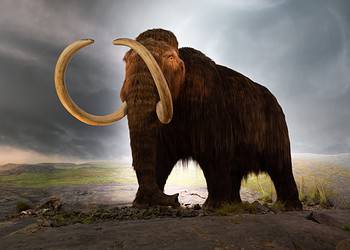
Millions of years ago, long-necked sauropods and snarling Tyrannosaurs roamed a world thick with heat, teeming forests, and volatile skies. Now, their fossilized teeth are offering scientists a startling new way to read the prehistoric air those giants once breathed.
In a new study out today, researchers have shown that dinosaur teeth hold a chemical record of the atmosphere itself. By analyzing rare oxygen isotopes preserved in the enamel, the scientists have reconstructed snapshots of atmospheric carbon dioxide (CO₂) from the Jurassic and Cretaceous periods.
The results are striking: CO₂ levels during the Mesozoic were far higher than they are today — up to four times the preindustrial level.
“Our findings provide a new research avenue to reconstruct a direct link between land-living vertebrates and the atmosphere they breathed,” paleontologist and geochemist Thomas Tütken of Johannes Gutenberg University in Mainz told Science Alert.
Fossil Teeth as Climate Diaries
To get there, the team turned to a little-used isotope: oxygen-17. Normally, scientists rely on marine proxies like plankton shells or soil carbonates to infer past CO₂ levels, but those methods offer an indirect picture, mostly of ocean conditions. Dinosaur teeth, by contrast, offer a direct window into what life on land was like millions of years ago.
“Even after up to 150 million years, isotopic traces of the oxygen molecules of the Mesozoic atmosphere that the dinosaur inhaled are still preserved in fossil tooth enamel,” Tütken explained. “They can tell us something about the ancient atmosphere composition and global photosynthetic biomass production.”
This is because vertebrates — including dinosaurs — take in oxygen not just for breathing, but also for metabolizing food. That oxygen ends up embedded in their hard tissues like bones and teeth. And in enamel, the record is remarkably stable.
“The analysis of the three oxygen isotopes in dental enamel allows us to also measure the proportions of oxygen assimilated with respiratory air and drinking water,” Tütken said.
A Volcanic Breath of Air
The team, led by geochemist Dingsu Feng of the University of Göttingen, analyzed enamel powders taken from dinosaur specimens housed in museum collections across Europe. They focused on fossils from the Late Jurassic and Late Cretaceous, ranging in age from about 150 to 66 million years old. The teeth came from North America, Europe, and Africa.
What they found confirmed earlier climate estimates but with greater clarity. During the Late Jurassic, CO₂ levels reached approximately 1,200 parts per million (ppm), about four times the preindustrial baseline. In the Late Cretaceous, levels dropped slightly to around 750 ppm — still three times the norm before industrialization.
Today, Earth’s atmospheric CO₂ hovers around 430 ppm, and rising.
But two teeth — one from a Tyrannosaurus rex, another from a Kaatedocus, a long-necked sauropod — showed something strange: anomalously high oxygen-17 signals.
“There were surprising high triple oxygen isotope anomalies found… compared to the other near-contemporaneous dinosaurs,” Tütken said. “These potentially reflect atmospheric spikes of high CO₂ levels during the time these individual dinosaurs were alive.”
The likely culprit? Volcanoes.
During the Mesozoic, volcanic activity was common and immense. The researchers suspect that those spikes in CO₂ were caused by eruptions — possibly linked to flood basalt events like the Deccan Traps, a massive volcanic province in what is now India. These eruptions would have pumped colossal volumes of greenhouse gases into the air.
And the teeth, remarkably, recorded it.
Plants, Photosynthesis, and Food Webs
Beyond CO₂, the teeth tell another story — one of plants and productivity.
According to the isotope ratios, photosynthetic activity during the Mesozoic was double today’s levels. That means the plants weren’t just growing, they were thriving. High CO₂ and warm temperatures created a greenhouse world where dense vegetation stretched across continents — even into polar regions.
“The information obtained through our study on the global primary production provides important evidence of both marine and terrestrial food webs,” said evolutionary ecologist Eva M. Griebeler of Johannes Gutenberg University. “The available plant biomass limits the abundance and number of species and the length of food chains in the ecosystem.”
In other words, more plants meant more herbivores — and more carnivores to hunt them. The very size and abundance of dinosaurs may have hinged on this plant productivity.
Looking Back to See Ahead
This method is more than a neat party trick for paleoclimatologists. It could change how we understand Earth’s deep past — and future.
“Our method provides us with completely new insights into Earth’s past,” said Feng. “We now have the possibility to use fossilized tooth enamel to study the composition of the atmosphere of the early Earth and the productivity of terrestrial and marine vegetation back then.”
The next target? The Permian–Triassic extinction event, also known as The Great Dying. This was a global extinction event that struck 252 million years ago, long before dinosaurs evolved. That disaster, linked to massive volcanic eruptions in Siberia, wiped out around 90 percent of marine species and 70 percent of land vertebrates.
By applying the same oxygen isotope technique to fossils from that era, the researchers hope to better understand how extreme CO₂ spikes affected life on Earth — and how ecosystems might respond in the future.
Why This Matters Now
Today’s CO₂ levels are the highest they’ve been in at least 800,000 years, and human emissions are pushing them higher every year. While we’re far from the Mesozoic highs, the pace of change is unprecedented.
This new method allows scientists to measure ancient atmospheric shifts with greater precision than ever before. It’s a powerful reminder that Earth’s climate can change — and sometimes quickly. And that the clues to those changes may lie not in air bubbles or ocean sediments, but in the teeth of creatures long turned to stone.
“Dinosaurs are becoming climate experts,” Feng said. “Their teeth recorded the climate more than 150 million years ago—and at last we are able to read that record.”
The findings appeared in the Proceedings of the National Academy of Sciences.






